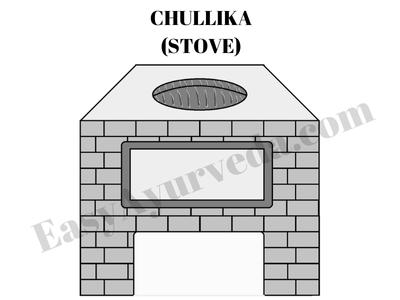Koshti (Furnace or Fireplace) of Rasashastra
To do Satwapatana of Dhatus and to do purification of Satwas, Koshtis are useful. Many substances of Rasashastra yield Satwa only after subjecting them to very high temperature. In some procedures of Satwapatana, a small sized Koshti would be sufficient. But in some, a bigger sized koshti is necessary. To enhance fuel efficiency and to make the process cost effective, and less laborious, different Koshtis are explained.
Table of Contents
Introduction
During ancient times acharyas used to construct different sized, different shaped fireplaces for uniform heating of substances.
Definition of Koshthi
सत्त्वानां पातनार्थाय पातितानां विशुद्धये ।
कोष्ठिका इविधाकाराः…..॥ (र.र.स.१०/३२)
sattvānāṃ pātanārthāya pātitānāṃ viśuddhaye |
koṣṭhikā ividhākārāḥ…..|| (ra.ra.sa.10/32)
Koshthis are the fireplaces of different shapes and sizes, used for the purpose of sattvapatana (separataion of active principles) and purification of substances.
Read more: Concept of sodhana (purification) in Rasashastra
Chullika (Stove)

It’s a simple stove. Useful in preparation of many dosage forms like Avaleha, kwatha, Taila, Kupipakwa etc.
Synonyms: Angeti, Angaara Dhanika, hasantika & Angaarashakati.
It’s made of bricks and cement. There should be provision for inserting the wood logs and to remove the ash. The inside width should be more and at constricted at the top.
Now a days LPG, electricity, coal, kerosene are used as fuel.
Acharyas have explained 4 types of stove with wood as fuel.
1. One faced stove – used for Patana.
2. Two faced stove – used for Swedana
3. Three faced sove – used for kashta Swedana
4. Four faced stove – used for Satwapatana.
Angara Koshti
नृपहस्तमितोत्सेधे तदर्धायामविस्तृता ।
मध्यतश्चतुरस्रा च मृदा च परिलेपिता ॥
चतुरङ्गुलमानेन रन्ध्रेण परिशोभिता ।
नालिकां समकोणाञ्च रन्ध्रेण तिर्यक निवेशयेत् ॥
नालिकाया मुखे चैव भस्त्रवक्त्रं निवेशयेत् ।
आपूर्य कोकिलैः कोष्ठीं द्रव्यमूषान्वितां धमेत् ॥
सत्वाणां पातने चेयं विशेषाद्विनियुज्यते । (र. तं ३/२५-२८)
nṛpahastamitotsedhe tadardhāyāmavistṛtā |
madhyataścaturasrā ca mṛdā ca parilepitā ||
caturaṅgulamānena randhreṇa pariśobhitā |
nālikāṃ samakoṇāñca randhreṇa tiryaka niveśayet ||
nālikāyā mukhe caiva bhastravaktraṃ niveśayet |
āpūrya kokilaiḥ koṣṭhīṃ dravyamūṣānvitāṃ dhamet ||
satvāṇāṃ pātane ceyaṃ viśeṣādviniyujyate | (ra. taṃ 3/25-28)
A crubicle compound is prepared with bricks, of 1 Rajahasta height and ½ Rajahasta width. In one of its walls at about middle height, an opening with a door is made of 1-1 ½ Vitasti width. Near to this wall, an opening to connect the blower is made. The roof is constructed over the compound, having one Angula thickness. An opening is made in the roof of one Angula diameter. The material to be subjected to Satwapatana and the coal is fed into the furnace from top and blower is attached at the bottom.
Use: The Angara Koshti is useful in extracting Satwa out of hard substances, which require very high temperatures.
Patala Koshti
दृढभूमौ चरेद्गर्तं वितस्या सम्मितं शुभम् ।
वर्त्तुलं चाथ तन्मध्ये गर्त्तमन्यं प्रकल्पयेत् ॥
चतुरङ्गुल विस्तार निम्नत्वेन समन्वितम् ।
गर्त्ताधरणि पर्यन्तं तिर्यकनाल समन्वितम् ।
किंचित् समुन्नतं बाह्यं – गर्ताभिमुखनिम्नगम् ॥
मृंच्चक्री पञ्चरन्ध्राढ्यां गर्भगर्त्तोदरे क्षिपेत् ।
आपूर्य कोकिलैः कोष्ठीं प्रधमेदेकभस्त्रया ॥
पातालकोष्ठिका ह्येषा मृदूनां सत्वपातनी ।
ध्मानसाध्यपदार्थानां नन्दिना परिकीर्त्तिताम् ॥ (र. र. स. १०/३९-४२)
dṛḍhabhūmau caredgartaṃ vitasyā sammitaṃ śubham |
varttulaṃ cātha tanmadhye garttamanyaṃ prakalpayet ||
caturaṅgula vistāra nimnatvena samanvitam |
garttādharaṇi paryantaṃ tiryakanāla samanvitam |
kiṃcit samunnataṃ bāhyaṃ – gartābhimukhanimnagam ||
mṛṃccakrī pañcarandhrāḍhyāṃ garbhagarttodare kṣipet |
āpūrya kokilaiḥ koṣṭhīṃ pradhamedekabhastrayā ||
pātālakoṣṭhikā hyeṣā mṛdūnāṃ satvapātanī |
dhmānasādhyapadārthānāṃ nandinā parikīrttitām || (ra. ra. sa. 10/39-42)
To make a Patala koshti, A cylindrical pit is dug in the ground of 12 Angula depth and diameter. At the floor of this pit, one more cylindrical pit of 4 Angula depth and diameter is dug. Between the 12 Angula pit and the four Angula pit,a sieve with five holes is kept.
Read more: Ayurvedic measurements
The bottom of four Angula pit is connected to a pipe, which is connected to blower. Now the pit is filled with coal, a Musha with its contents is kept over it and fire is lit. Fire is maintained with the help of the blower.
Use: The patala Koshti is used for the purpose of Satwapatana of soft substances.
It is called as patala koshti because it is made underground.
Gara Koshti
द्वादशाङ्गुलनिम्ना या प्रादेशप्रमिता तथा ।
चतुरङुलतश्चोर्ध्वं बलयेन समन्विता ॥
भूरिच्छिद्रवतीं चक्रीं बलयोपरि निक्षिपेत् ।
शिखित्रांस्तत्र निक्षिप्य प्रधमेद्वङ्कनालतः ॥
गारकोष्ठीयमाख्याता मृष्टलोहविनाशनी । (र. र. स. १०/४३-४४)
द्वादशाङ्गुलनिम्ना या प्रादेशप्रमिता तथा ।
चतुरङुलतश्चोर्ध्वं बलयेन समन्विता ॥
भूरिच्छिद्रवतीं चक्रीं बलयोपरि निक्षिपेत् ।
शिखित्रांस्तत्र निक्षिप्य प्रधमेद्वङ्कनालतः ॥
गारकोष्ठीयमाख्याता मृष्टलोहविनाशनी । (र. र. स. १०/४३-४४)
dvādaśāṅgulanimnā yā prādeśapramitā tathā |
caturaṅulataścordhvaṃ balayena samanvitā ||
bhūricchidravatīṃ cakrīṃ balayopari nikṣipet |
śikhitrāṃstatra nikṣipya pradhamedvaṅkanālataḥ ||
gārakoṣṭhīyamākhyātā mṛṣṭalohavināśanī | (ra. ra. sa. 10/43-44)
dvādaśāṅgulanimnā yā prādeśapramitā tathā |
caturaṅulataścordhvaṃ balayena samanvitā ||
bhūricchidravatīṃ cakrīṃ balayopari nikṣipet |
śikhitrāṃstatra nikṣipya pradhamedvaṅkanālataḥ ||
gārakoṣṭhīyamākhyātā mṛṣṭalohavināśanī | (ra. ra. sa. 10/43-44)
To make Gara kosti, a furnace of 12 Angula height with one Pradesha length and breadth. In this furnace, at about four angula height from the bottom, a brim is constructed and on this brim, an iron sieve is fitted. The furnace is filled with coal, Musha is placed and subjected to heat with the help of blower. Thi setup is called as Gara Koshti.
Gara Koshti is called as so because, usually, it is constructed with mud of pond.
Use: This is usually used in the Marana process of Loha.
Note: Angara and gara Koshti are constructed above ground. Where as Patala Koshti is constructed by digging a pit. (as the name suggests, Patala means underground).
In Patala Koshti and Gara koshti, iron sieves are used.









